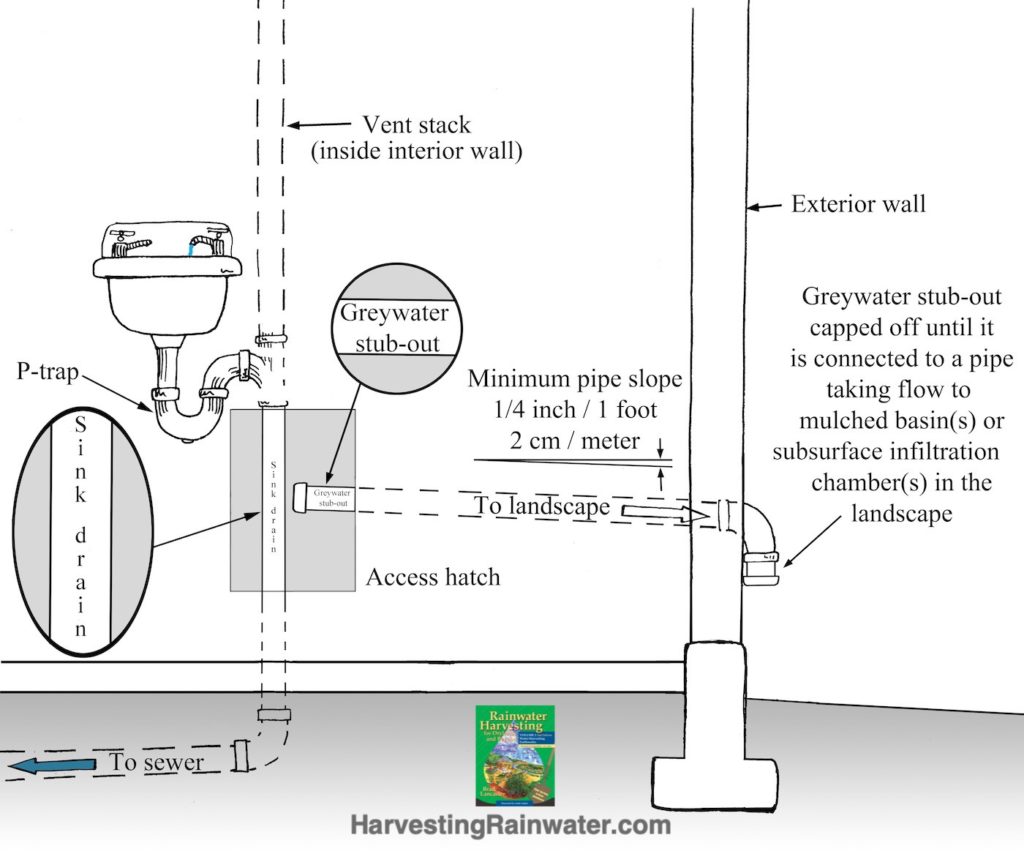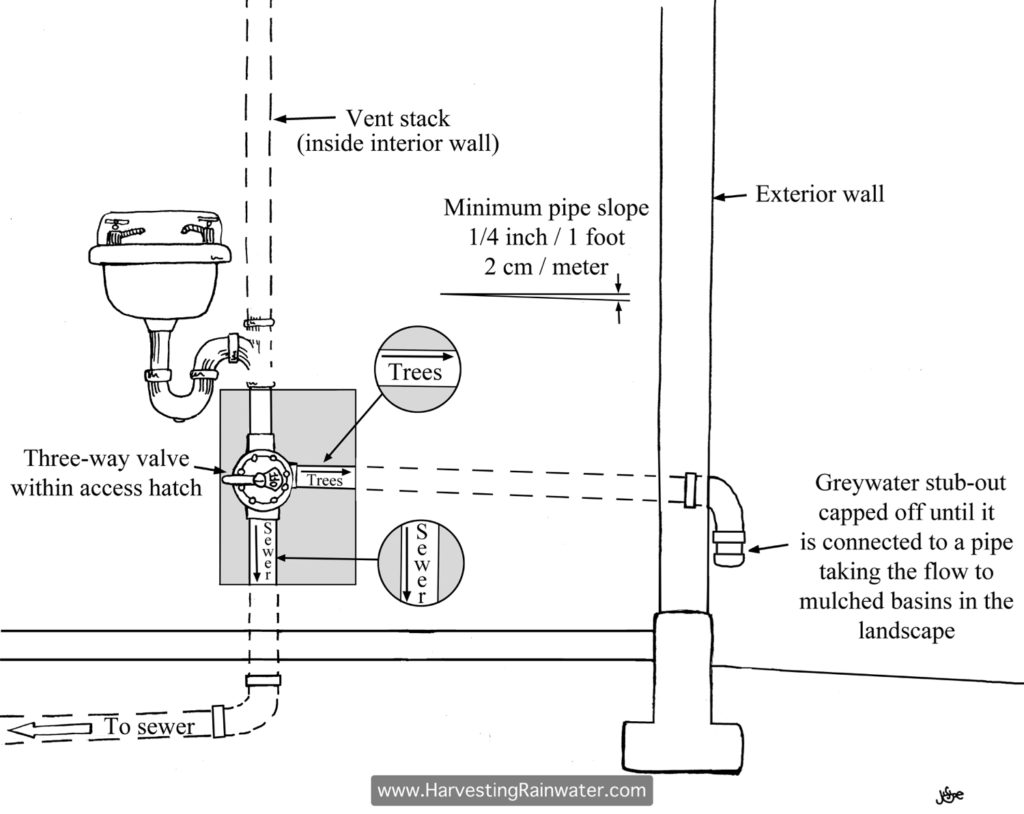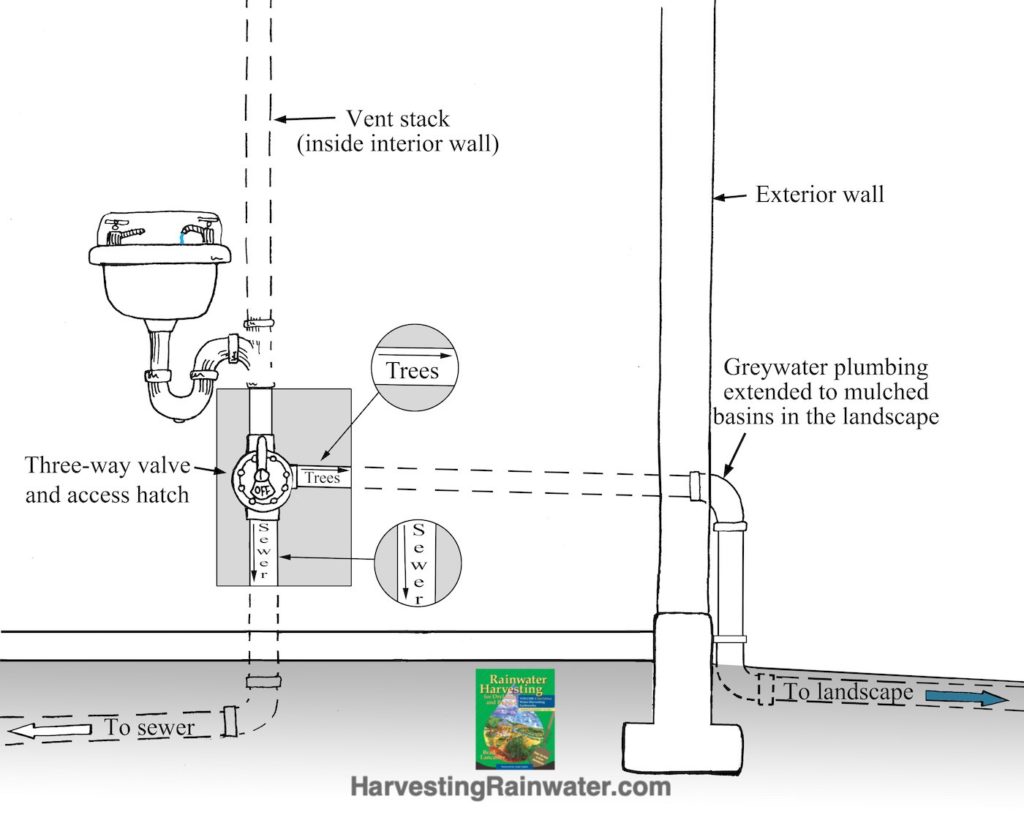Greywater-Harvesting Stub-Outs
Greywater-harvesting stub-outs are built-in plumbing connections allowing for easy future access to a home’s drain-water stream…
Incorporating greywater-harvesting drains/stub-outs at the time of construction (or major renovation) of a home is generally the easiest and least expensive time to do so. That way you don’t need to later cut and jack-hammer through walls and floors to get to the plumbing. See (figs. 1A, B, C).
The following is adapted from, and meant as a supplement to, chapter 12 of Rainwater Harvesting for Drylands and Beyond, Volume 2, 2nd Edition

A bathroom sink and drain with a greywater stub-out which is capped off and waiting to be hooked up to the greywater flow. Pipes are labeled at time of installation.
Note: The stub-out should exit the building as high as possible (even above grade) for the maximum number of gravity-fed distribution options within the landscape.
The stub-out can be made accessible for later hookup by installing a removable section of drywall or latched door, or by leaving it exposed within a below-sink cabinet.
.

This is closer to complete, stub-out installation than in fig. 1A, because all interior plumbing is done. All the homeowner needs to do to use the system is to connect the exterior section of the stub-out to pipes (maintaining a minimum 2% slope) distributing the greywater into the landscape (see fig. 1C).
.

The three-way valve is turned so the greywater is now directed to the landscape.
See the greywater chapter of Rainwater Harvesting for Drylands and Beyond, Volume 2, 2nd Edition for various options where the pipe outlets within the landscape
Ideally the upstream end of the stub-out is located for easy and convenient access beside the greywater source, such as inside the bathroom beneath the sink, rather than an inconvenient placement outside or under a solid floor. The lower/downstream end of the stub-out pipe is routed to sections of yard that have ample space to install water-harvesting basins. Stub-outs remain capped until a greywater distribution system is set up in the landscape, then they can be connected to the drain plumbing and the greywater can be put to use.
Often it is ideal if the stub-outs are connected to the drain plumbing with a three-way valve, or a multi-drain system for washing machines (no valve needed), (see chapter 12 of Rainwater Harvesting for Drylands and Beyond, Volume 2, 2nd Edition), enabling the user to direct the greywater to the landscape or the sewer/septic depending on what goes down the drain, the weather, or the saturation of the soil in the landscape.
Greywater lines originating inside a home should be diverted downstream from P-traps and vents to inhibit the entry of insects, vermin, or odors into the house via greywater lines. Three-way diverter valves can often be installed as high in the system’s flow as the vent/sewer stack, downstream of the P-trap.
Greywater lines must be diverted upstream of toilet sewage flow. Flushed toilet water is blackwater or sewage, and must never mix with the greywater you use in your landscape.
Existing homes lacking stub-outs can typically be retrofitted fairly easy where interior sinks are against exterior walls, with a multi-drain pipe or laundry-to-landscape system for washing machines, and with outdoor showers (all described in Rainwater Harvesting for Drylands and Beyond, Volume 2, 2nd Edition). See what works for you, your site, and your lifestyle. You don’t have to do it all, just start somewhere. Anything is an improvement, and the more you do, the better!
See here for some of the City of Tucson’s resources/illustrations on how stub-outs might be designed and installed in new-home construction. See here for the City of Tucson’s greywater-harvesting stub out ordinance
See here for my recommendations/comments on how these resources and the city’s greywater stub-out ordinance could be improved.
See here for additional greywater stub-out information by Art Ludwig.
See here for how you can direct the greywater from your stub-out into your landscape with gravity-fed branched-drain greywater distribution plumbing
For more
See the new, full-color, revised editions of Brad’s award-winning books
– available a deep discount, direct from Brad:

Volume 1
See appendix 4 to estimate the water needs of your plants, and thus how much of their water needs could be met by your harvested greywater, and other free on-site harvested waters.
Chapter 2 shows you how to estimate your household’s greywater volumes.

Volume 2
See chapter 12 of Rainwater Harvesting for Drylands and Beyond, Volume 2, 2nd Edition for many different ways you can freely distribute your greywater via gravity (no pumps needed) from your stub outs to your landscape.
Also shows you how to estimate your household’s greywater volumes.
